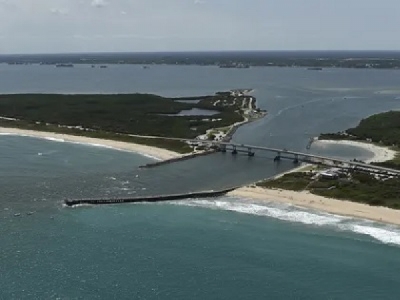
Posted on January 7, 2019
Preliminary work has begun on a project to dredge about 150,000 cubic yards of sand out of the Sebastian Inlet and spread most of it on Indian River County beaches.
Ferreira Construction of Stuart, which won the bid for the Sebastian Inlet District’s $2.9 million project, will put an 18-foot dredge on the west end of the inlet and a booster dredge near the south side of the State Road A1A bridge.
Pipes will send about 120,000 cubic yards of sand — enough to fill 8,000 to 12,000 average-size dump trucks — to about 1.5 miles of beaches from the McLarty Treasure Museum and south past the Ampersand Beach access.
Another 30,000 cubic yards — that’s 2,000 to 3,000 dump trucks — will be stockpiled for emergency beach fill and dune repair. Gopher tortoises were removed recently from the fenced six-acre storage site on the north side of the inlet in Sebastian Inlet State Park.
Ferreira is scheduled to connect and install pipes from Monday through Jan. 25. Dredging a sand trap in the inlet for beach placement is set to run from Jan. 28 through Feb. 25.
Environmental precautions
The Florida Institute of Technology will monitor water quality around the dredge to protect sea grass shoals in the Indian River Lagoon and at the sand discharge point to protect beaches and the nearshore ocean waters.
Also, a trained observer will stop work if manatees or sawfish are seen within 50 feet of the dredge.
Beach work is supposed to be finished by the end of February so the tilling and grading don’t interfere with sea turtle nesting season. The first nesting females typically arrive in early March.
If beach renourishment isn’t completed by March 1, Ecological Associates Inc. of Jensen Beach will monitor the site through the end of the 2019 nesting season in November to to make sure there are no negative impacts, such as steepening of the beach after grading.
Dredging the rest of the channel will begin in mid-March, with the storage area filled and work finished in mid-April.
Environmental Associates also will monitor effects on shorebirds, including the piping plover, after April 1 as needed.
Immediately after project completion, marine biologists with CSA Ocean Sciences Inc. in Stuart who conducted a comprehensive nearshore survey at the site last summer will do a post-project survey to ensure no sand has migrated to cover the important habitat south of the inlet.
The district’s commission “takes seriously its commitment to preserving natural resources and protecting important habitats and wildlife around the inlet,” said Martin Smithson, administrator of the Sebastian Inlet District. “We know from experience that there’s a way to conduct these state-mandated projects in a way that has zero impact so the beauty of what we all enjoy at the inlet is around for generations to come.”
The Legislature created the district in 1919 to maintain the inlet’s navigational channel between the Atlantic Ocean and the lagoon on the Indian River-Brevard county line.
Source: TCPalm





